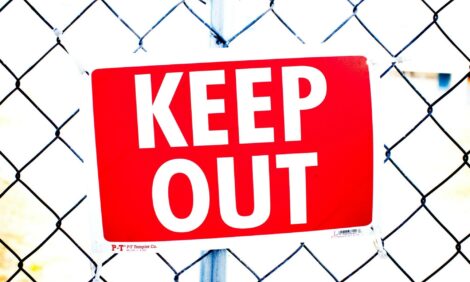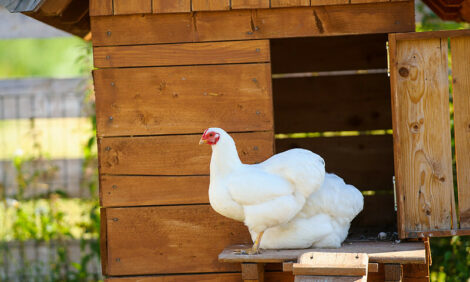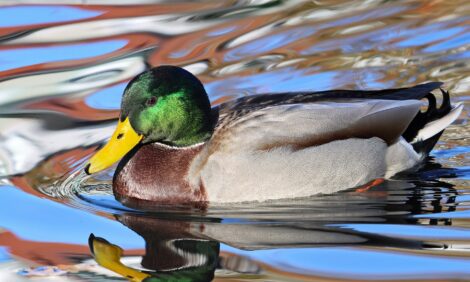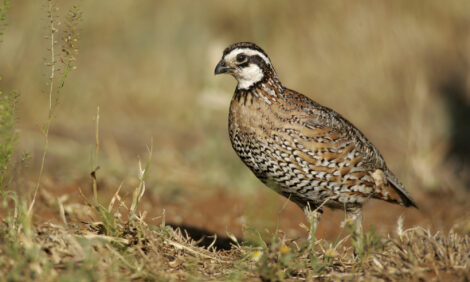



US Poultry Industry Manual - Backyard poultry & product movements, marketing
Learn more about biosecurity needs and surveillance of backyard flocksPart of Series:
< Previous Article in Series Next Article in Series >
Editor's Note: The following content is an excerpt from Poultry Industry Manual: The Foreign Animal Disease Preparedness and Response Plan (FAD PReP)/National Animal Health Emergency Management System (NAHEMS) Guidelines which is designed to provide a framework for dealing with an animal health emergency in the United States. Additional content from the manual will be provided as an article series.
Transportation methods
Transportation methods used vary according to the scope and needs of a particular operation. Out of necessity the owner of a few backyard chickens may simply place the birds into a small box, cage, other container, or even a paper grocery bag and transport them by car.
Larger operations that transport birds or eggs to swap meets or farmers markets may utilize larger cages and trucks or vans dedicated to this purpose. Gamefowl roosters being transported to cock fight events must be held in individual cages to prevent fighting. For this purpose, various types of individual cages, or cages designed to carry multiple birds with each bird within its separate compartment are utilized. These cages fit into the trunk of a car or the back of a truck and can be easily disguised or hidden. Birds that are being smuggled across borders frequently are hidden by variety of means to avoid detection.
Breeding and fighting season
Movement of poultry for breeding or cock fighting purposes is commonly done in a variety of ways as described in the previous article.
Quarantined birds
Smuggling of various birds, particularly psittacine birds, is a big business particularly from Latin American origins. Gamefowl are commonly taken into and out of the United States, both legally and illegally, for breeding and/or cock fighting events by many different means.
During the exotic Newcastle disease quarantine in California in 2002-03, it was common for gamefowl to be moved around illegally in spite of restrictions imposed by state and federal quarantines against such movements. The purpose of this illegal movement was to avoid having the flock, or at least selected birds within the flock, depopulated due to infected or exposed birds being traced or epidemiologically connected to that flock.
One of the favorite ingenious ways for gamefowl owners to move birds was to place them in rental pickups obtained from the same commercial firm that supplied vehicles to the Federal-State Taskforce. The taskforce had leased a substantial number of pickups and other box trucks and to identify those vehicles had finger painted an identifying number on the inside of the windshield. In order to avoid detection, many gamefowl owners leased the same types of pickups or trucks from the same rental company and painted similar looking numbers on the inside of the windshield. Using these “look-alike” vehicles, the birds would be moved in, out, or within the quarantined area without arousing any suspicion and with little chance of being detected. This scheme was not discovered until after the outbreak was over and the taskforce disbanded. After the fact, we learned that many movements of this type had taken place over a long time interval while quarantines were in place.
Marketing methods and practices
Backyard poultry may be marketed in any number of ways including direct sales on premises, taking birds to swap meets or auctions or even by internet sales. Approximately 17.8% of backyard flocks sold or gave away live birds in the year preceding the NAHMS survey (3). The NAHMS study found that backyard flocks that had introductions of new birds within the past year ranged from 28.3% to 51.7% with an average of about 36% (3). About 3.6% of backyard bird owners moved birds to congregation points where other birds are present. Most of these movements were within the same county or state of residence. As previously discussed, taking live birds into and out of congregation points introduces a risk that disease pathogens may be transported along with the birds. As a means of reducing this risk, it is important for disease control officials to maintain a liaison with market operators and to conduct regular training in biosecurity methods and to conduct regular surveillance testing of birds moving in these markets.
Biosecurity measures for avian influenza and exotic Newcastle disease
An incursion of a foreign animal disease, such as avian influenza or exotic Newcastle disease, necessitates an emergency response to contain and eradicate the outbreak as quickly as possible. This is vitally important to protect the production industry of the state(s) and the entire country, as well as to ensure continuity of a plentiful and wholesome food supply from the affected industry and protect the public health. In preparation for such an adverse event many government agencies have developed response plans and have stockpiled some of the common materials needed for the initial response to an outbreak. Part II of the current document is a summary of the organized response to an exotic disease introduction. Various reference documents are available that provide further guidance to disease control activities in response to a highly contagious disease event. (10, 11).
Backyard or hobby poultry producers will be affected by state and federal quarantines, if they are located within the area. Similarly, infected premises and contact premises that are backyards will be handled in the same way as any other premises where the highly contagious disease occurs. Movement restrictions may apply to poultry and birds in backyards within quarantined areas. Use of a permit system as part of the movement controls may allow uninfected entities to continue to operate (11).
General principles of biosecurity share considerable similarity across all species and across different categories within a given species, for example the six types of poultry represented in this manual. Differences in biosecurity programs for various types of poultry operations come from variation in the type of premises involved, the magnitude of the operation, the amount of risk of disease at the specific premises, funding available, and the practicality of the intervention considering the risk-benefit to be achieved by including each component under consideration into the flock biosecurity plan.
Backyard poultry biosecurity is extremely variable due to a multitude of reasons including the design, construction, location, size, layout of the facility, and what’s in the areas adjacent to the operation as well as the cost. To provide adequate biosecurity to protect the wide variety of backyard poultry operations, it may be necessary to apply non-standard approaches and innovative thinking to fit the specific premises at hand, while keeping in mind the objectives and intent of a biosecurity plan.
By definition, biosecurity is the application of any protective practice or intervention method that could decrease the risk of disease by preventing or diminishing the movement of pathogenic organisms into or out of a premises. Biosecurity reduces the probability of disease occurrence in a poultry flock to the lowest possible level. In the process of preparing a biosecurity plan, careful consideration must be given to the various options available, the practicality of each intervention method considered, the cost/benefit of the practice, and the feasibility of executing each component of the biosecurity protocol for the specific premises. Ideally, strictly-practiced, effective biosecurity is a critically important component of successful poultry production in all types of poultry operations from small backyard flocks to the largest commercial operations. An additional benefit of using good biosecurity practices is that they protect against all diseases and are not limited or applicable only to highly contagious diseases, such as avian influenza (AI) or exotic Newcastle Disease (END).
The three basic components of flock biosecurity include: isolation, traffic control, and sanitation (12). Isolation means the confinement of birds within an environment that can be controlled and protected, and refers to physical separation away from other poultry, people and equipment. Whenever possible, poultry facilities should be located well away from lakes or rivers that will attract wild waterfowl, roads on which poultry may be hauled, and other poultry production premises. In the case of backyard facilities, however, there is little or no control over what may be located in the adjacent environment, the backyard’s location or what kinds of poultry may be kept on a nearby premises.
Fencing around the facility and a buffer zone around poultry houses that is maintained free of vegetation to discourage rodent activity will be beneficial. Traffic control refers to all persons, vehicles, equipment and any other items that enter, move within the premises, or exit from the poultry facility. The fewer movements into or out of the facility, the less likely disease organisms will be brought onto or taken out of the premises. Sanitation is the cleaning and disinfection of equipment, vehicles, materials and other items, and the cleanliness of personnel on the premises. Sanitation is composed of about 90% cleaning and 10% disinfection. Because very few disinfectants are effective in the presence of organic matter, such as manure, mud or other debris, it is necessary to remove this material by thorough cleaning before a disinfectant is applied.
When doing cleaning and disinfection of backyard poultry facilities it is essential to remember:
- It is impossible to disinfect soil, litter or manure, therefore, spraying disinfectant solutions on the ground (soil) has no beneficial effect.
- Chemical disinfectants were not intended to be sprayed on live birds, either as a disease prevention or treatment method.
- Chemical disinfectants (such as formaldehyde or Virkon-S and many others) are not to be sprayed on the skin (bodies) of workers as part of a shower-in/shower-out process.
- Chemical disinfectants may be dangerous and must be used according to directions, e.g. formalin or formaldehyde is toxic and a known carcinogen and may be used only in certain applications.
- Infectious disease agents may be introduced into, or escape from a poultry production facility in many ways including:
- Movements of diseased birds, or birds that have recovered from an illness, but have become carriers of the
- causative organism, or movements of healthy birds into a contaminated environment.
- Vehicles, shoes, and clothing of visitors, workers, delivery or service personnel that move between flocks
- or premises.
- Fomites including feeders, waterers, cages, coops, carts, or other equipment that may be moved or shared
- between different premises or even in multiple houses on the same premises
- Carcasses of dead birds following improper disposal
- Movement and disposal of manure or other waste materials
- Contaminated water, feed or feed bags, soil, or litter
- Rodents, wild animals, and free flying birds or insects
- Contaminated trucks or vehicles of any kind
- Eggs and egg handling equipment
Of the many ways that disease organisms may be introduced into a flock, the most critical methods involve movements of contaminated birds, people and equipment. Whenever possible, non-porous, impervious materials, such as metal or plastic cages, coops, and other equipment should be used because they are more easily cleaned and disinfected. Birds should be obtained from reliable sources and then should be isolated for 2-4 weeks before being introduced into the rest of the flock. People should be restricted from entering the premises unless it is essential for them to do so and then they should wear protective outer clothing and shoe covers.
Similarly, vehicles and equipment should not be brought onto the premises unless necessary, and unless thoroughly cleaned (e.g. by high pressure power washing) and disinfected before entry and upon exiting the facility. Movements of persons and equipment within a given premises should be made beginning with the youngest birds first and progressing to the oldest, and from the resident birds first then moving toward the isolation area last. Another important component of backyard poultry biosecurity is the exclusion and control of rodents, wild birds, and insects from the premises.
These disease control principles should be applied and/or modified to suit the conditions of a particular premises and practiced accordingly at all times. However, practicality should be continuously kept in mind and strict biosecurity methods should be even more strenuously applied during times when outbreaks of diseases such as AI or END are known to be occurring.
Poultry husbandry needs
Husbandry needs for a backyard poultry flock will be the same in the face of an outbreak as they would be in normal circumstances unless the flock is selected for depopulation.
Product handling
Backyard poultry producers seldom have any product other than young or adult birds, or eggs either for consumption or for hatching, or that are in the process off being hatched by the hens. Baby or juvenile birds could be considered product, but for purposes of depopulation and disposal, all live birds on a premises should be handled in the same way. On occasion, nests full of eggs, usually goose, duck, or gamefowl eggs, are encountered and appraised with assistance from the owner. The eggs are then disposed of by including them with the depopulated birds.
Surveillance
Surveillance includes two types of disease control activities. First, is the search component or looking for the presence of susceptible species, that is, finding out where the birds are and where they are not located. Door-to-door surveys, and completion of a questionnaire when birds are found, are frequently used to document which premises have poultry. In an outbreak situation, this activity is most often done in quarantined areas around infected premises to define the extent of the outbreak. It is especially critical to conduct surveillance around commercial poultry production facilities when an outbreak exists in the general area. The purpose of this activity is to monitor poultry near commercial facilities as a means of protecting the commercial industry. From the data obtained, maps may be generated that show the location of poultry and bird-owning premises and show spatial relationships between the various types of facilities.
The second surveillance component, is the continued monitoring and testing of flocks located in or near quarantined areas and of suspect or high risk premises through repeated surveillance visits to observe birds for signs of illness and to collect samples for disease testing. OIE Guidelines specify minimum surveillance to obtain adequate data to ensure freedom from disease. Those guidelines should be consulted when establishing a surveillance program after an outbreak has been controlled.
After the outbreak, continued surveillance is conducted to demonstrate disease free status. Once disease free status is established, surveillance may be conducted as a means of early detection in case disease returns. In the interim, door-to-door surveys provide very little benefit considering the cost and time involved in conducting the activity. A better method for early detection of a new incursion of disease is to use surveillance testing at poultry concentration points. This includes random testing of birds in market channels, such as swap meets, auctions, live bird markets, and other concentration points, such as fairs, shows and other expositions. It is of utmost importance to keep and maintain good records of surveillance activities in a database that can be readily and easily accessed.
People
Personnel assigned to surveillance activities must first be given adequate training in the protocols for biosecurity, sampling methods, and sampling quantities (how many birds to sample in the various situations and what types of samples to collect and how to prepare the samples and accompanying paperwork for submission to the laboratory). Some types of surveillance may be limited to canvassing neighborhoods looking for poultry and gathering data pertaining to the flocks when found.
Vehicle traffic
Surveillance crews should park their vehicle on the street outside the premises whenever possible. If suitable parking is not available outside the premises, or outside the farm gate, vehicles should be parked as far away from the area containing the birds as practical. The intent of this is to reduce the risk of bringing disease organisms into a premises, or out of the premises on the vehicle. In addition, tires and wheel wells should be sprayed with disinfectant on arrival and again before departing the premises. It is good practice to take the vehicle through a commercial car wash that includes a high pressure power wash with soap and hot water, if possible, at the end of each day’s operations.
Disease monitoring
This is another application of surveillance, usually applied to premises outside the infected zone or buffer zone, within the free area, part of the control area that have demonstrated that they should not be classified as infected premises, contact premises, suspect premises or at-risk premises. Also please refer to Section 5, above.
Sample collection
Taskforce personnel conducting surveillance sampling and diagnostic crews that respond to sick calls will be collecting samples for laboratory testing to determine disease status of the flock of interest. It is critically important that these crews practice very strict biosecurity while visiting premises and obtaining samples. The following section gives a generic example of a protocol followed by diagnostic and surveillance crews for visiting a backyard poultry facility. However, both surveillance and diagnostics crews should follow protocols established for the taskforce event at hand. (10)
- DO NOT enter premises with dead or sick birds. If you observe dead or sick birds, leave the premises and call your supervisor or the Administrative Assistant in Epidemiology and report your findings.
- A biosecurity line must be established between the premises and the vehicle. Use the biosecurity procedures and personal protection equipment (such as Tyvek suits, double boots, double rubber gloves, hairnet, face mask, and goggles). Refer to the Standard Operating Procedure Manual for instructions, or in the absence of such a manual, contact the operations supervisor for direction.
- Two members of the three-person surveillance team will enter the premises. One crew member will hold and handle the bird(s). The other crew member will collect oropharyngeal and cloacal swabs and handle media tubes.
- Oropharyngeal and/or cloacal swabs must be collected and handled according to prescribed procedures. Refer to the standards for the area in which you are operating, i.e., the surveillance zone, or the quarantine zone.
- The third crew member is the clean person who remains at the biosecurity line established between the premises and the vehicle. This crew member calls for the premises identification information and takes decontaminated samples at the biosecurity line and stores them in an ice chest that will be used to transport them. This crew member also processes the trash when the other two crewmembers return to decontaminate at the biosecurity line prior to returning to the vehicle at the end of the collection.
- The two crew members who collect the samples should complete the paperwork and prepare sample tubes for submission to the laboratory before crossing the biosecurity line.
Sample submission
Taskforce management should provide protocols for collecting samples. Similarly, diagnostic laboratories should provide specific guidelines for collecting samples and preparing them for submission to the laboratory. Continuous interaction of taskforce and laboratory management will be necessary throughout the disease control program.
Reference: "USDA APHIS | FAD Prep Industry Manuals". Aphis.Usda.Gov. 2013. https://www.aphis.usda.gov/aph...
The manual was produced by the Center for Food Security and Public Health, Iowa State University of Science and Technology, College of Veterinary Medicine, in collaboration with the USDA Animal and Plant Health Inspection Service through a cooperative agreement.














